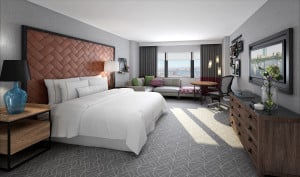
A rendering of the Westin Copley, where the guestrooms utilize sustainable vinyl tile and recycled and sustainable carpets.
Airbnb and online hospitality services have changed the game for the hospitality industry, there’s no denying that fact. However, with new competition comes new strategy for the hotels themselves. As Boston expands its investment in hotels, including developments in the Seaport, Downtown and Dorchester just to name a few, it’s all the more important that this new reality is understood.
Hotels are feeling the pressure to take not only their design, but also the experience they offer guests, to the next level. While Airbnb allows for homeowners to open their doors to strangers, hotels are honing in on that same “homey” feel. So how can a hotel make you feel at home when there are actual homes you can opt to stay in during your travels? A good design certainly helps. Here are a few ways hotels are changing to reshape the travel experience.
Draw A Crowd
In a city like Boston, which has plentiful restaurant and bar options, hotels need to provide food and beverage experiences that draw someone to want to book a stay. One way to do this is to design the space to become a destination for anyone, not just hotel guests. Rooftop bars with food and entertainment draw the public in and offer another reason to go to a hotel. Unique food experiences that go beyond the “continental breakfast,” such as custom coffee bars and healthy dining services, differentiate classic food options.
The Matadora restaurant and bar at the Hilton Boston/Woburn Hotel in Woburn has been designed as a destination within a 7-story atrium space. The restaurant is nestled into the dramatic volume and provides a comfortable retreat for guests. It is managed by the award-winning COJE Group.
Think Beyond A Traditional Gym
Instead of the standard gym facilities with only a few machines, amenities have become more individualized and specialized, including yoga mats and free weights provided in-room. This focus on wellness and health also incorporates fresh food options from local restaurants and designs that encourage activity. Rooms are designed with hardwood floors rather than carpets that can harbor mites and allergens. Sustainable, non-emitting materials create an eco-friendly experience.
The Westin Copley Hotel uses sustainable luxury vinyl tile within the guestrooms along with recycled and sustainable carpets. The design of the guestroom walls incorporates a wall covering that is low in VOC, and the natural hardwoods are Forest Stewardship Council-certified. In addition, the guest room vanity structure was reused to eliminate use of additional materials.
Another example is the atrium within the Hilton Boston/Woburn hotel that embraces natural light, eliminating additional energy use during the day. Many live plants are strategically located throughout the hotel, and the patio design features a live green wall. Tying back to the physical connection to Boston, the backdrop of the check-in area features reclaimed wood slats that are inspired by the railway connection to the city.
Integrating ‘Home’ Into Design
Lastly, hotels are trying to feel like a home through design, largely to combat the competitive edge Airbnb boasts.
The Westin Copley hotel consists of 820 guestrooms and suites, and incorporates both a residential and luxurious feel. Natural bold elements of worn brick, authentic New England colors, and unexpected moments of local art all contribute to the overall feeling of a Boston home.
Hotels are enhancing new designs through a focus on amenity, wellness and sustainability; but also to feel more like home. These factors must flow seamlessly together to provide a memorable experience for guests. Basic amenities no longer excite an informed traveler who is looking for an experience that immerses them in their travels and that feels like they are right at home.
Jacqueline McGee is principal of hospitality at Perkins + Will in Boston.




 |
| 




